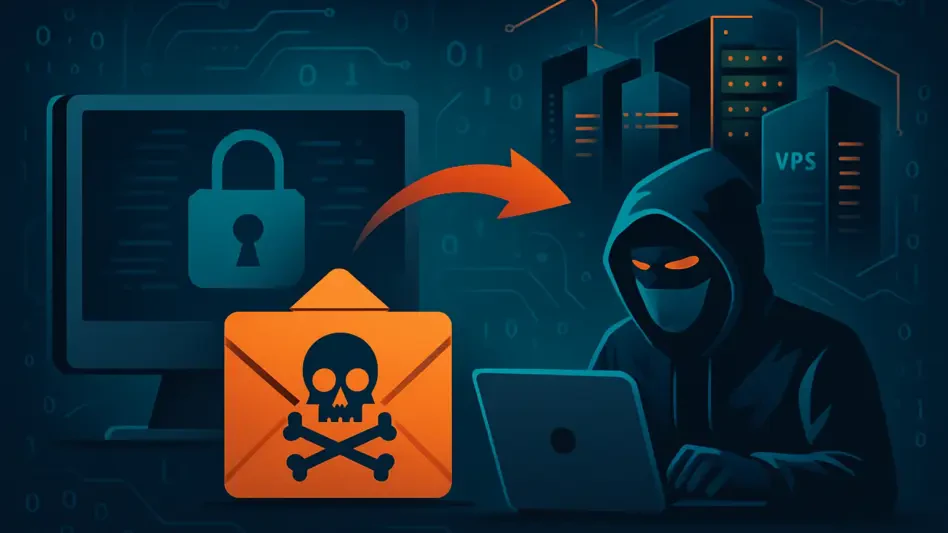In an era where digital infrastructure underpins nearly every aspect of business operations, a disturbing trend has emerged that threatens the security of corporate email systems across industries. Cybercriminals have found a potent tool in inexpensive Virtual Private Servers (VPS), using these low-cost cloud solutions to orchestrate sophisticated Software-as-a-Service (SaaS) hijacking attacks. These attacks, which target business email accounts with alarming precision, exploit the anonymity and legitimacy provided by VPS providers to bypass traditional security measures. Costing as little as $5 a month, such servers offer clean IP addresses that allow malicious activities to blend seamlessly with legitimate traffic. This stealthy approach has seen a sharp rise in recent months, posing a significant challenge to organizations reliant on email for communication and transactions. As attackers refine their methods, understanding the mechanisms behind these threats becomes critical for safeguarding sensitive data.
Unveiling the Mechanics of VPS-Driven Attacks
The ingenuity of cybercriminals lies in their ability to turn affordable VPS services into powerful weapons for infiltrating SaaS platforms, particularly business email systems. By renting servers from providers known for offering budget-friendly options, attackers gain access to IP addresses that appear trustworthy to security filters. This enables them to initiate logins and other activities that mimic legitimate user behavior, often evading detection by static security protocols. Once inside an account, they operate covertly, maintaining access while the legitimate user remains unaware of the intrusion. Their tactics include setting up subtle email rules with vague names to redirect or delete specific messages, such as those related to invoices or phishing attempts, ensuring their presence remains hidden. This method of hijacking not only compromises individual accounts but also opens doors to broader network exploitation, making it a pressing concern for cybersecurity teams globally.
Beyond the initial breach, the use of VPS in these attacks facilitates a deeper level of manipulation that traditional defenses struggle to counter. Attackers often exploit timing and location anomalies to bypass Multi-Factor Authentication (MFA), a cornerstone of modern security. Suspicious logins from distant locations, occurring moments after genuine user activity, highlight their strategic precision in avoiding red flags. In some documented cases, tools like remote access software are deployed to establish a persistent foothold, enabling prolonged data theft or further malicious schemes. The clean IP addresses provided by VPS services lend an air of legitimacy to these actions, a tactic described by industry experts as “renting trust.” This deceptive practice underscores the need for security systems to evolve beyond rule-based detection and focus on identifying unusual patterns that signal unauthorized access, even when it appears legitimate on the surface.
The Stealthy Tactics Behind Email Hijacking
Delving into the specific strategies employed, cybercriminals using cheap VPS services demonstrate a chilling level of sophistication in maintaining stealth during SaaS hijacking. Rather than relying on overt phishing or brute-force password theft, attackers gain entry to email accounts while users are still logged in, effectively masquerading as trusted entities. Once inside, they craft hidden email rules designed to obscure their activities, such as automatically deleting correspondence related to fraudulent transactions or sensitive topics from sent folders. These rules are often given ambiguous names to avoid suspicion, allowing attackers to monitor communications or redirect critical messages without alerting the account owner. This covert approach maximizes their window of opportunity to extract valuable information or orchestrate financial scams, often over extended periods, before any anomaly is detected by conventional monitoring tools.
Another alarming aspect of these attacks is the deliberate attempt to secure long-term control over compromised accounts, further enabled by the anonymity of VPS servers. In several instances, attackers have targeted multiple user accounts within an organization, applying similar deceptive email rules across them to maintain widespread access. Efforts to alter account recovery settings are also common, ensuring that even if initial access is disrupted, they can regain entry at a later time. Such persistence reflects a calculated intent to embed themselves within a company’s digital ecosystem, often for purposes ranging from data theft to launching secondary attacks. The low barrier to entry provided by budget VPS options has democratized these advanced tactics, allowing even less-experienced cybercriminals to execute impactful campaigns. This trend signals a clear shift in the threat landscape, where affordable technology is weaponized with devastating effect against unprepared organizations.
Adapting Defenses to an Evolving Threat
Reflecting on the past, the rapid escalation of VPS-driven SaaS hijacking attacks exposed significant gaps in traditional cybersecurity frameworks. Conventional approaches, heavily reliant on static rules and predefined patterns, proved inadequate against the adaptive and nuanced strategies of cybercriminals who leveraged low-cost servers for their schemes. The doubling of malicious activity on certain VPS platforms in recent months served as a stark warning of how accessible tools amplified the reach of these threats. Organizations that failed to prioritize dynamic, behavior-based detection often found themselves vulnerable to stealthy intrusions that bypassed even robust safeguards like MFA. The historical reliance on outdated models left many businesses scrambling to address breaches after sensitive data had already been compromised.
Looking ahead, the lessons from these past challenges point to actionable strategies for fortifying defenses against VPS-enabled attacks. Businesses must invest in advanced security systems capable of learning and identifying anomalous behaviors, such as unexpected logins from unusual locations or atypical user actions within email accounts. Adopting a proactive stance, companies should regularly audit email rules and account settings to detect unauthorized changes early. Additionally, educating employees on recognizing subtle signs of compromise, even when no overt breach is apparent, can serve as a critical line of defense. As cybercriminals continue to exploit affordable technology, the cybersecurity community must advocate for collaborative efforts to monitor and mitigate the misuse of VPS services. By staying ahead of these evolving tactics, organizations can better protect their digital assets and maintain trust in their communication systems.








